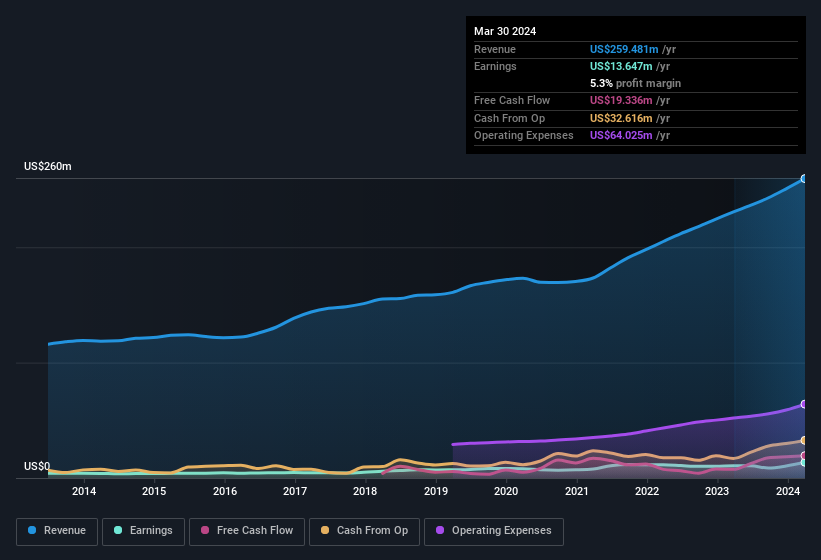- United States
- /
- Trade Distributors
- /
- NasdaqGM:TRNS
Transcat's (NASDAQ:TRNS) Promising Earnings May Rest On Soft Foundations
Transcat, Inc. (NASDAQ:TRNS) just reported some strong earnings, and the market reacted accordingly with a healthy uplift in the share price. We did some analysis and think that investors are missing some details hidden beneath the profit numbers.
View our latest analysis for Transcat

One essential aspect of assessing earnings quality is to look at how much a company is diluting shareholders. Transcat expanded the number of shares on issue by 20% over the last year. As a result, its net income is now split between a greater number of shares. To talk about net income, without noticing earnings per share, is to be distracted by the big numbers while ignoring the smaller numbers that talk to per share value. You can see a chart of Transcat's EPS by clicking here.
How Is Dilution Impacting Transcat's Earnings Per Share (EPS)?
As you can see above, Transcat has been growing its net income over the last few years, with an annualized gain of 73% over three years. But EPS was only up 56% per year, in the exact same period. And at a glance the 28% gain in profit over the last year impresses. But in comparison, EPS only increased by 17% over the same period. And so, you can see quite clearly that dilution is influencing shareholder earnings.
Changes in the share price do tend to reflect changes in earnings per share, in the long run. So it will certainly be a positive for shareholders if Transcat can grow EPS persistently. But on the other hand, we'd be far less excited to learn profit (but not EPS) was improving. For that reason, you could say that EPS is more important that net income in the long run, assuming the goal is to assess whether a company's share price might grow.
That might leave you wondering what analysts are forecasting in terms of future profitability. Luckily, you can click here to see an interactive graph depicting future profitability, based on their estimates.
Our Take On Transcat's Profit Performance
Each Transcat share now gets a meaningfully smaller slice of its overall profit, due to dilution of existing shareholders. Therefore, it seems possible to us that Transcat's true underlying earnings power is actually less than its statutory profit. Nonetheless, it's still worth noting that its earnings per share have grown at 56% over the last three years. The goal of this article has been to assess how well we can rely on the statutory earnings to reflect the company's potential, but there is plenty more to consider. So if you'd like to dive deeper into this stock, it's crucial to consider any risks it's facing. Every company has risks, and we've spotted 2 warning signs for Transcat you should know about.
This note has only looked at a single factor that sheds light on the nature of Transcat's profit. But there is always more to discover if you are capable of focussing your mind on minutiae. Some people consider a high return on equity to be a good sign of a quality business. So you may wish to see this free collection of companies boasting high return on equity, or this list of stocks with high insider ownership.
Valuation is complex, but we're here to simplify it.
Discover if Transcat might be undervalued or overvalued with our detailed analysis, featuring fair value estimates, potential risks, dividends, insider trades, and its financial condition.
Access Free AnalysisHave feedback on this article? Concerned about the content? Get in touch with us directly. Alternatively, email editorial-team (at) simplywallst.com.
This article by Simply Wall St is general in nature. We provide commentary based on historical data and analyst forecasts only using an unbiased methodology and our articles are not intended to be financial advice. It does not constitute a recommendation to buy or sell any stock, and does not take account of your objectives, or your financial situation. We aim to bring you long-term focused analysis driven by fundamental data. Note that our analysis may not factor in the latest price-sensitive company announcements or qualitative material. Simply Wall St has no position in any stocks mentioned.
About NasdaqGM:TRNS
Transcat
Provides calibration and laboratory instrument services in the United States, Canada, and internationally.
Flawless balance sheet with questionable track record.
Similar Companies
Market Insights
Community Narratives





